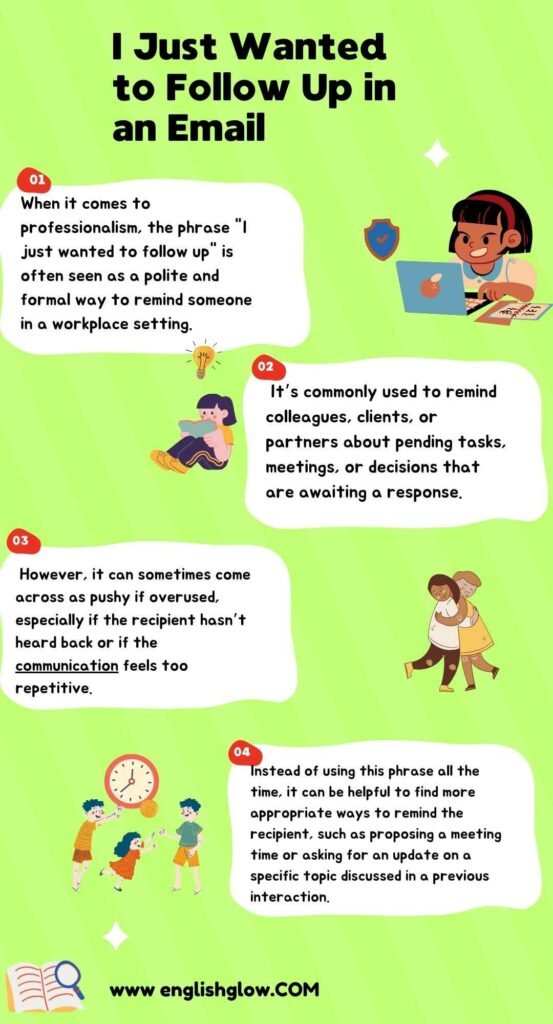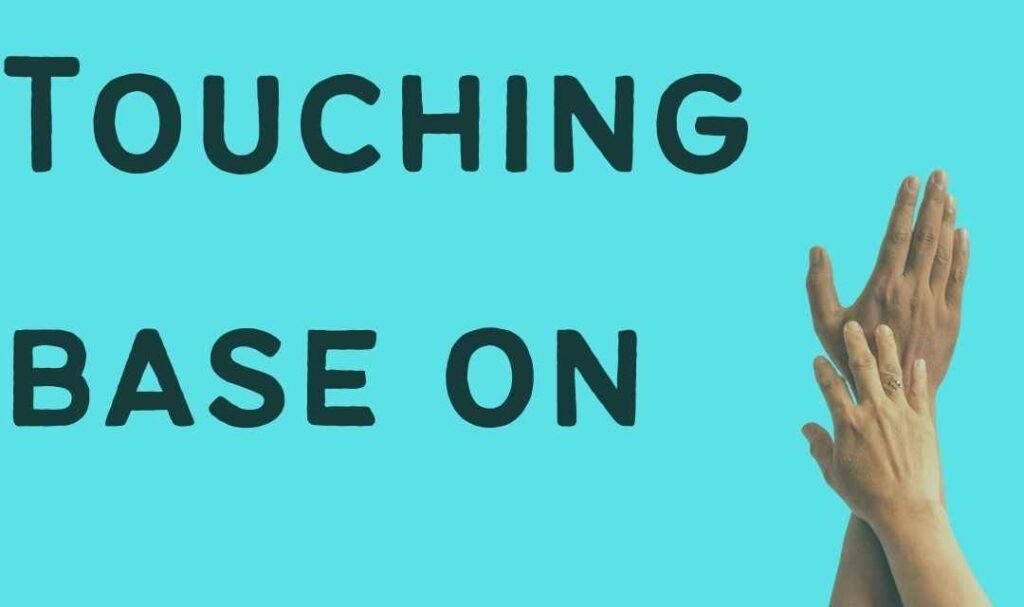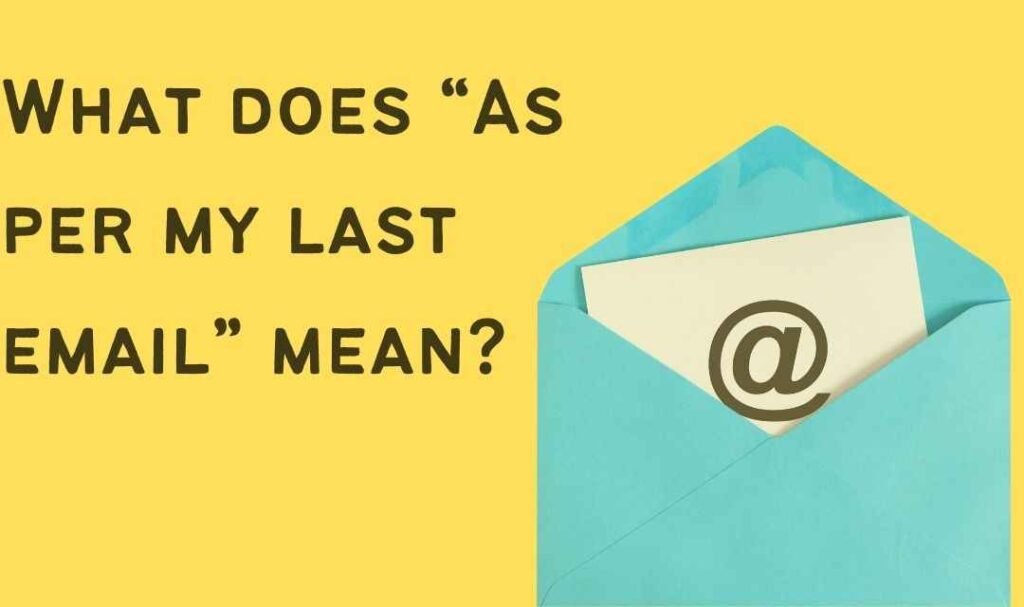When you want to follow up in a professional email, it’s important to approach the situation with tact and consideration for both the context and the relationship with the sender. Instead of saying, “I just wanted to follow up,” you can use a thoughtful response like, “I wanted to check in regarding our previous conversation to see if there’s any update.” This expression conveys your sincerity and shows that you’re respectful of their time. You can also say, “I would appreciate any updates on the matter,” which maintains clarity and avoids any sense of pressure. It’s important to ask questions that help you gain a better evaluation of their intentions without overstepping boundaries. By offering a polite reminder or asking about next steps, you make the conversation flow with finesse while keeping things professional and considerate of the other person’s comfort levels. This approach ensures that the dialogue remains respectful and doesn’t lead to any misinterpretation of your behavior.
Is It Professional to Say “I Just Wanted to Follow Up”?
When it comes to professionalism, the phrase “I just wanted to follow up” is often seen as a polite and formal way to remind someone in a workplace setting. It’s commonly used to remind colleagues, clients, or partners about pending tasks, meetings, or decisions that are awaiting a response. However, it can sometimes come across as pushy if overused, especially if the recipient hasn’t heard back or if the communication feels too repetitive. Instead of using this phrase all the time, it can be helpful to find more appropriate ways to remind the recipient, such as proposing a meeting time or asking for an update on a specific topic discussed in a previous interaction. It’s important to strike the right balance between polite and persistent to maintain professionalism without seeming demanding.
10 Other Ways to Say “I Just Wanted to Follow Up” in an Email
Looking to change up your email language? Here are 10 professional alternatives to refresh your follow-up messages: You can try “Touching base on” or “Following up on” to start your message. If you want to sound a bit more casual, “Checking in” or “See where we stand” are great options. For a more formal tone, you could use “Inquiring about” or “Requesting an update”. If you’re looking to be more direct, “Reaching out to remind” or simply “Reminding you of” can work well. All these phrases offer a way to keep your follow-up emails polite, professional, and clear, ensuring your message is heard without feeling too pushy.
You might enjoy reading: Loot vs Lute Uncovering the Surprising Connection
1. Touching base on
“Touching base on” is a great professional alternative to the phrase “I just wanted to follow up.” It’s slightly informal but still keeps the tone light and friendly, making it a good fit for many professional interactions. This phrase is perfect when you want to check in with someone without sounding too stiff or distant. It strikes a good balance between being approachable and maintaining professionalism, making it ideal for industries with a casual communication style or situations where a positive tone is key. Whether it’s to strengthen the relationship or just stay updated on the matter, this expression helps maintain sincerity while keeping things professional.
2. Following up on our previous conversation
“Following up on our previous conversation” is a formal and professional way to remind the recipient about a recent discussion or prior discussion. This phrase is ideal when you want to reinforce important points from a meeting and emphasize their importance, ensuring that both parties are on the same page moving forward. It helps maintain continuity and provides a clear reference to prior agreements or next steps, making sure nothing gets forgotten. This approach adds clarity and professionalism to the interaction, especially in situations where follow-up is crucial for progress on projects or agreements
3. Checking in on
If you’re looking for a way to follow up that feels both polite and professional, “Just checking to see where we stand on” is a solid choice. This phrase gently nudges the conversation forward without being pushy, making it a perfect option when you’re unsure of the current status of a task, request, or discussion. It’s ideal when you need to get a sense of the progress or any decisions that may have been made. By using this, you not only show you’re invested in the outcome but also that you’re looking for an update without imposing. It helps keep the dialogue open, ensuring that the other party knows you’re still engaged and awaiting their response, while maintaining a smooth, respectful communication flow..
4. Just checking to see where we stand on
If you’re looking to check in without sounding too formal, “Just checking to see where we stand on” is a great option. This phrase offers a friendly nudge while maintaining a professional and informal tone, perfect for when you need a periodic update on ongoing projects or discussions. It’s ideal for asking about the current situation or progress, especially when you don’t need an immediate answer, but just want to know how things are going. By using this, you’re conveying patience and understanding, giving the recipient room to respond at their convenience while keeping the communication open and respectful. This helps build a mutual understanding and keeps the conversation flowing smoothly.
5. I wanted to see where we are with
A great way to follow up in a slightly formal yet professional manner is by saying “I wanted to see where we are with”. This phrase allows you to ask for an update without seeming impatient or overly casual. It’s particularly useful when you’ve had prior conversations or activities and now need to know the current status or progress on something important, like a project with a timeline or deadline. By using this expression, you maintain a respectful relationship with the recipient while keeping the conversation focused and moving forward. It strikes the right balance between professionalism and a friendly check-in.
6. Inquiring about
When you need to inquire about something important and show a sense of urgency while remaining professional, this phrase works wonders. Using “Inquiring about” is a more formal approach to express direct interest in a specific area or topic. It’s perfect for official email correspondence, where you need to get clear information without sounding too demanding. This method is especially effective when the subject is of significant importance, and you want the recipient to know you are giving it your full attention. By using this, you convey both clarity and courtesy, ensuring the request is handled promptly without overwhelming the person you’re reaching out to.
7. Seeing if there’s any update on
“Seeing if there’s any update on” is a great way to casually seek information without being too direct. This phrase offers a polite and informal alternative to the usual follow-up lines, making it ideal for situations where you don’t want to sound demanding. It helps create a friendly atmosphere in your email while still being clear about what you’re asking for. If you need an update but want to maintain a more casual approach, this phrase works well without rushing the recipient. It’s a gentle way to prompt a response, especially if the topic is urgent, but you don’t want to pressure the person you’re emailing.
8. Wanted to ask about the status of
“Wanted to ask about the status of” is a formal and professional way to inquire about the progress or updates on a specific project or task. This phrase shows you’re seeking information while being considerate of the recipient’s time and efforts. It’s especially helpful in professional settings, where you’re waiting on a status update as a deadline approaches, but you don’t want to create unnecessary pressure. By using this expression, you can ask for updates without sounding harsh or impatient, maintaining a respectful tone that encourages a calm and thoughtful response.
9. Reaching out about
“Reaching out about” is a polite and professional choice when you want to show initiative in your communication. It’s a great way to highlight your proactive approach while seeking information or clarification on a specific matter. This phrase works well when you’re establishing or maintaining a connection, whether it’s for networking or starting a conversation with a new contact. It sets a positive tone, encouraging dialogue and fostering further engagement. By using this, you show respect for the recipient while ensuring that the conversation stays on track and productive.
10. Just wanted to remind you about
“Just wanted to remind you about” is a polite and somewhat informal way to follow up while emphasizing the reminder aspect of your message. It’s especially useful when you’re reminding the recipient about a previously agreed-upon deadline or action that is coming due. This phrase strikes the right balance, giving a gentle reminder without being annoying. It helps to keep things on track and ensures you can move forward on an agreed-upon action while not seeming too demanding. This approach makes it easier to nudge the recipient while keeping the tone respectful and considerate.
Writing Follow-Up Emails
Writing follow-up emails is all about finding the right tone that maintains professionalism while being considerate of the recipient’s time. One way to do this is by using “Just wanted to remind you about,” which is a polite and somewhat informal way to follow up. This phrase works well when you need to remind someone of a previously agreed-upon deadline or an action that’s coming due. It’s useful for keeping things on track, especially in scenarios where you don’t want to come across as annoying or demanding. With this gentle reminder, you can prompt the recipient to act without seeming pushy, making it ideal for situations where things are approaching and need to be completed.
Seven Other Ways To Say “I Just Wanted To Follow Up”
If you’re looking for variations to the phrase “I just wanted to follow up” in your follow-up emails, there are plenty of options to help you sound more professional. Instead of sticking with the same expression, you could try “Checking in on the status of” or “Just wanted to check in and see how things are going.” For a more formal tone, consider saying “I’m reaching out to ask for an update on” or “I wanted to follow up and ensure everything is on track with”. If you need to address a major issue or important task, use “I wanted to explicitly state my request for an update on” or “I’m seeking clarification on the current status of.” These alternatives help keep your communication clear, respectful, and varied, preventing the overuse of the same phrasing.
Writing Follow-Up Emails: What To Keep in Mind
When writing follow-up emails, it’s important to keep the tone both polite and professional. Be sure to use direct but respectful phrases that clearly convey your message without sounding rude. For example, instead of just saying “I just wanted to follow up,” you can try alternatives like “Just checking in on” or “Touching base regarding”. Always double-check your spelling and grammar, as errors can make your email appear unprofessional. Tools like LanguageTool can be helpful for correcting mistakes, especially when writing in multiple languages. Avoid vague responses and make your email clear and to the point. Also, remember to include please and thank you to add a courteous touch, and rephrase sentences if necessary to maintain the appropriate tone and style.
What does “As per my last email” mean?
“As per my last email” is a commonly used phrase in professional communication to refer to information addressed in a previous email. While it can be effective for setting expectations and reminding the recipient about important information or a call to action, it may sometimes be interpreted as passive-aggressive, especially if it feels like you are calling out or reminding someone in a hidden agenda way. To avoid rubbing people the wrong way, it’s best to use it sparingly and ensure you’re not repeating the same message unnecessarily. If you do use this phrase, make sure to be clear and concise, and consider offering a comprehensive update to keep everyone on the same page without feeling called out. It’s important to include relevant background information and set clear due dates or expectations when appropriate.
You might enjoy reading: Is County Capitalized? Unlock the Secret to Proper Usage
How to say “As per my last email” nicely: 6 alternatives
“As per my last email” can sometimes come across as infuriating or frustrating, especially when someone asks a question that has already been answered in a previous email. Instead of letting frustration take over, it’s helpful to find better ways to politely refer to the previous note. For example, you can say, “I just wanted to follow up on the points discussed in my previous email” or “I wanted to check in regarding the information I shared earlier.” You could also try, “I’d like to revisit the details I mentioned last time” or “Just to circle back on our earlier conversation.” Using phrases like these can keep the tone productive and professional while avoiding the sense that you’re reminding someone they didn’t read your last email.
Final Thoughts
Changing up the language in your emails can make a big difference when it comes to getting responses and keeping your emails fresh and engaging. Instead of always using the same phrases, try 10 alternatives to “I just wanted to follow up” to help your emails feel less robotic and more personal. Using the right phrase at the right time not only boosts professionalism but also adds a touch of warmth to your communication. This small change can help keep your emails from getting pushed down to the bottom of the inbox and can lead to better communication and building better relationships. When you use alternatives, you show that you care about how you interact, making your messages feel more genuine and less like they are pushing the recipient.
You might enjoy reading: Unique Phrases to Replace Don’t Threaten Me With A Good Time






